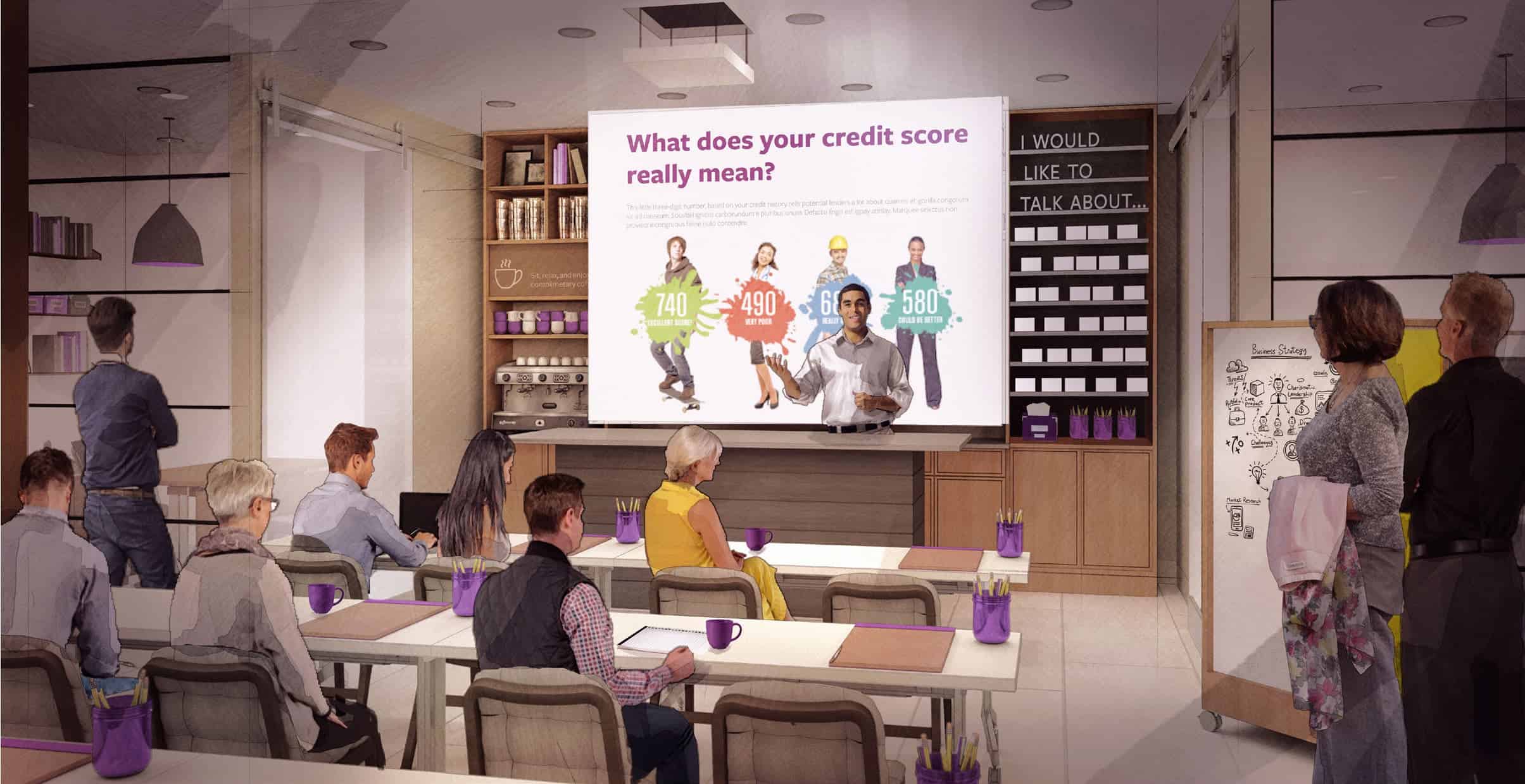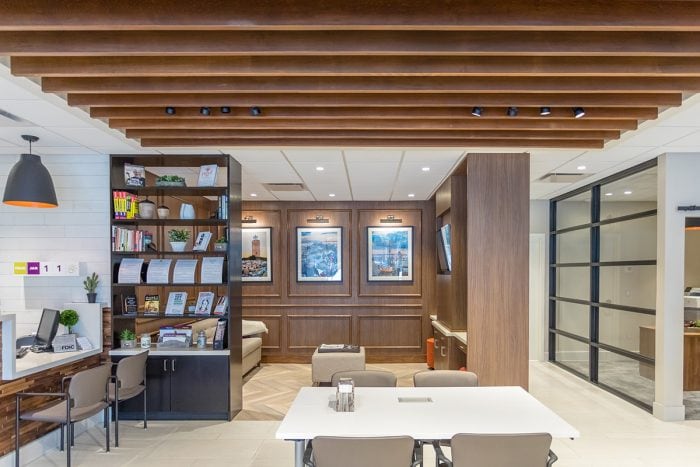
The Chelsea Groton Knowledge Library. A space to dwell, learn & interact.
Un-Banking the Bank
If it’s been a long time since you visited your local branch, statistics show you’re in good company. Adoption of electronic mobile banking has resulted in a decrease of in-branch foot traffic for many financial institutions. Chelsea Groton Bank sought to combat this trend by rethinking what a bank can do for its customers – to create an environment that fosters learning, connecting & problem solving. Our resulting design is based on a sound strategy for transforming the transaction through education and mentorship towards financial well-being.
Chelsea Groton Bank, the largest mutual bank in Eastern Connecticut, found themselves in a position similar to that of many financial institutions across the country today. With the success of online banking offerings, customers are finding increasingly less value in the traditional, physical branch and were coming into the branch less often. While many branches faced closures, Chelsea Groton instead thought to embrace this shift in the industry’s landscape, and in doing so, completely transformed their Groton, CT branch into a community destination for financial wellness and empowerment. Their aim was to redefine all that a bank can be and do for people, businesses, and communities, and they knew that in order to remain relevant in today’s marketplace, their branches needed to emulate that philosophy.
“We found a lot of inspiration from retailers like Apple, Verizon and Williams-Sonoma,” says bank President and CEO Michael Rauh, “where the store [is] a place to learn.”
Little’s approach to this repositioning project recognized the need for a comprehensive, multi-faceted strategy. Our design would require a highly strategic customer experience design in order to “un-bank the bank” and bring Chelsea Groton’s philosophy to life.
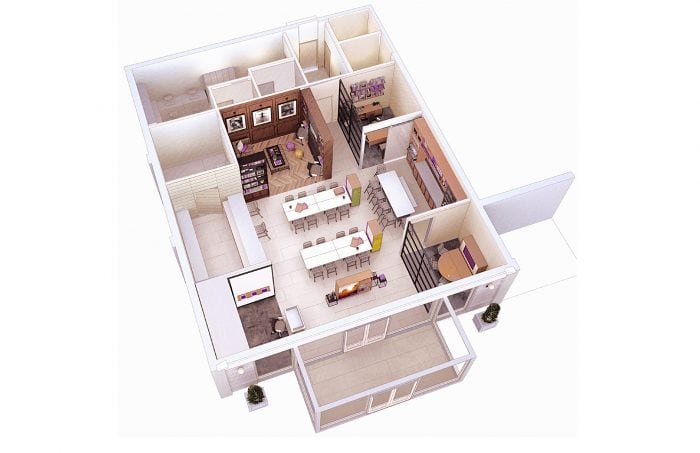
A birds-eye rendering of the concept illustrating how every inch of the 1,800sf space is used to enhance customer engagement.
Our primary challenge was that the standard branch environment and client service methodology was no longer resonating with today’s customers; it felt somewhat intimidating, and formal. We began with borrowing inspiration from that of hospitality environments, and incorporated elements that translated as warm, inviting, and approachable.
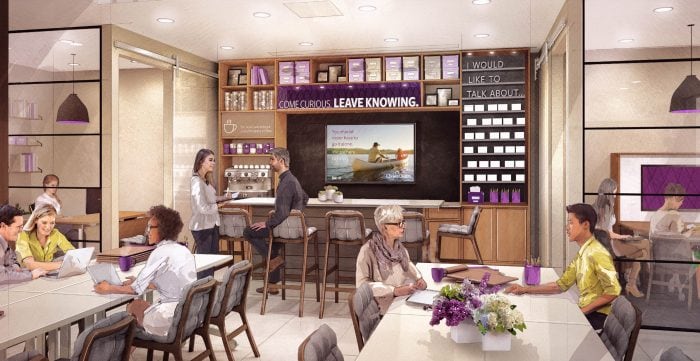
A rendering of the Knowledge Bar concept.
We broke down the traditional barriers that are typically found in the standard branch layout, both in the literal and figurative sense, and injected adaptable functionality for a variety of uses.
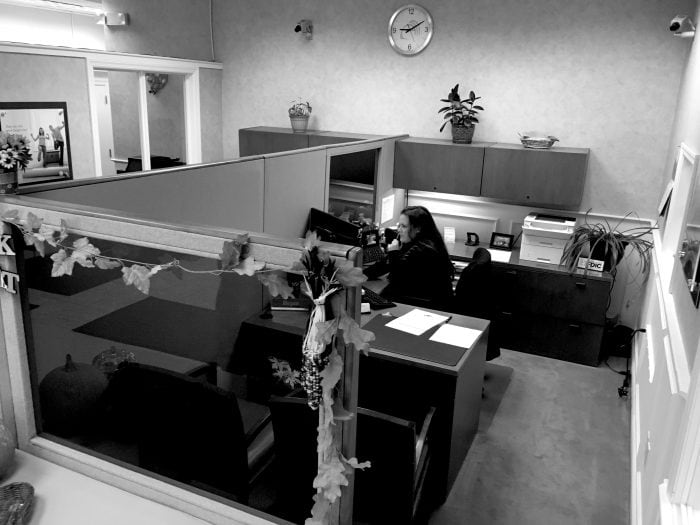
Before : Consultation
The team spent months researching in and out of category benchmarks environments and practices to identify best in class practices. Their research resulted in the realization that customers must develop habits that reinforce the educational information provided. They learned that customers preferred face-to-face learning environments, surrounded by like-minded friends and neighbors.
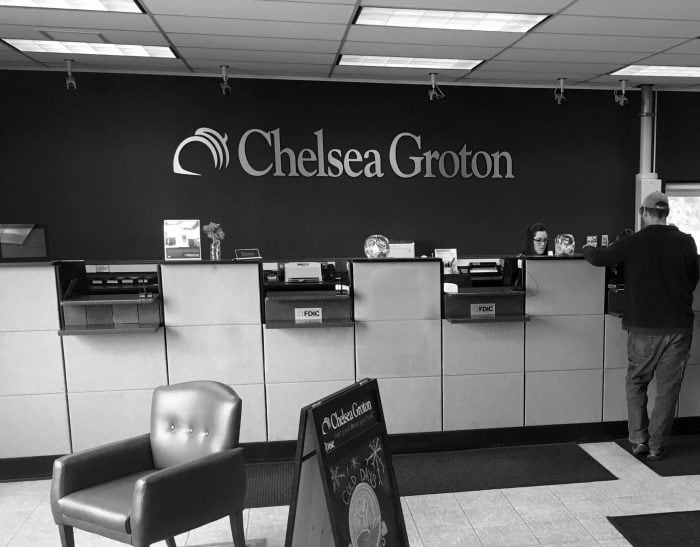
Before: Teller Line.
The new space is designed to be uber-flexible, offering many options for different types of interaction. At the entry we included a station more closely resembling that of a welcoming hotel concierge desk, adjacent to a touch down area and booth seating.
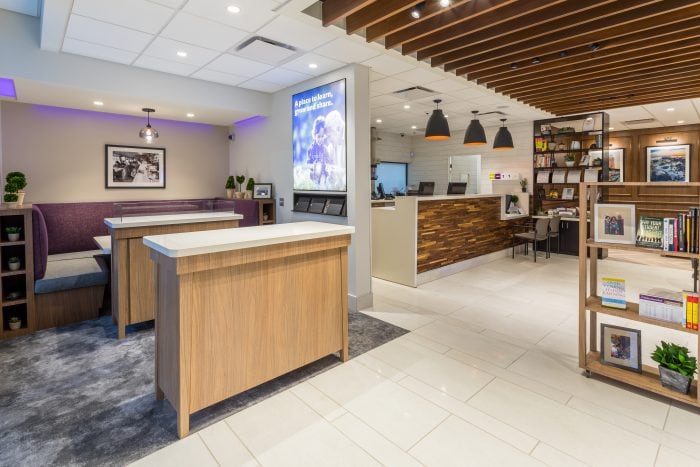
The entry Concierge and adjacent booth space greet the customer on arrival.
The teller line remained, however now features seating so it is more consultative – less about the transaction. This has been welcomed by locals and encouraged more shoulder-to-shoulder interaction between associates and customers, rather than having to converse over a separating wall. We created the Knowledge Library, a comfortable yet modern reading nook that provides customers with a more private space to learn about financial well-being at their own pace, and to become empowered in taking a proactive role in their financial health.
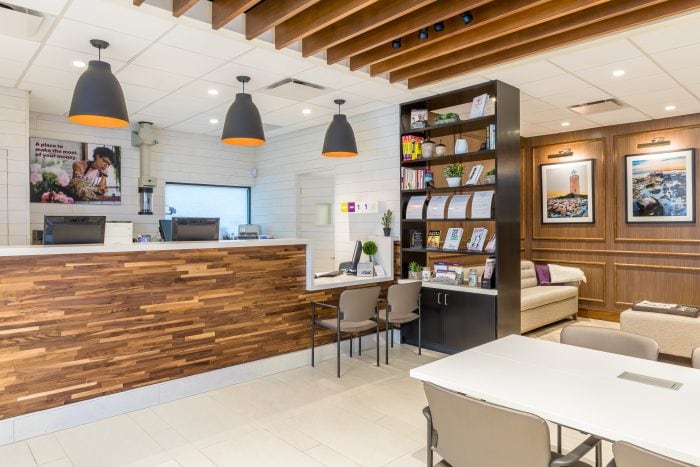
A re-designed teller line that transcends the transaction.
The Knowledge Bar further reinforces their educational program with a place where customers can be inspired while enjoying coffee and and engage in a conversation. The sense of community and hospitality were stressed here, as we aimed to mediate against the feelings of isolation and intimidation that customers can sometimes feel when it comes to the financial subject matter. Strategically placed tablets provide customers with the option of delving into a particular interest independently and can be leveraged by associates to enhance customer interface.
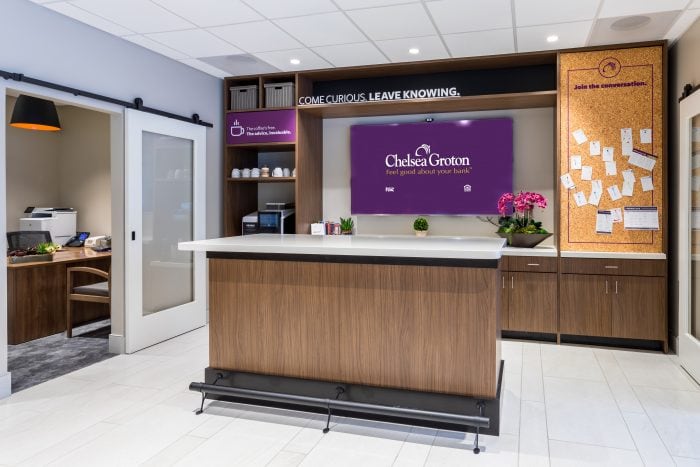
The Chelsea Groton Knowledge Bar and adjacent consultation rooms.
Chelsea Groton also introduced an offering of educational classes which we supported through the design of a hyper-flexible environment, where members of the community can learn about anything from savings plans to CPR. This demonstrated how the bank genuinely cares about their community and brings those customers closer to the brand.
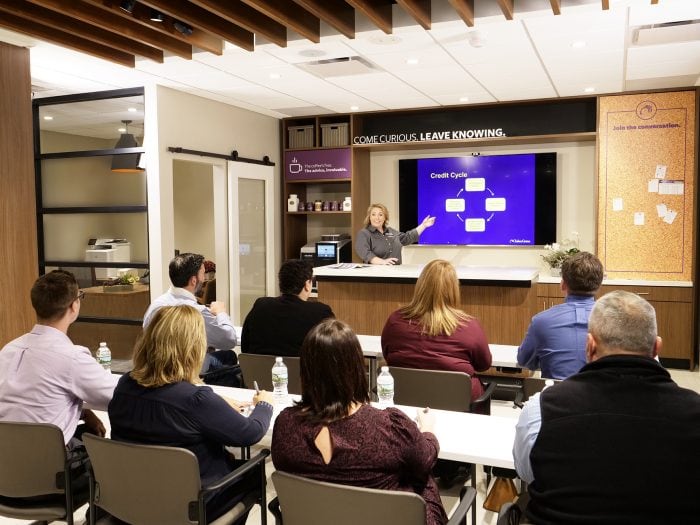
The uber-flexible branch space adapted for Miria’s educational class!
The Groton branch has evolved into much more than a place for transactions, more than simply a place to deposit checks. After learning more about the practices of instant loans at gdayloans.com.au, it’s now an atmosphere that fosters learning both in and outside the parameters of finance. The finished product has yielded incredible performance results : doubled their financial services income, tripled their loan production and now enjoys a customer experience score of 98.97%. Through leveraging the power of design, the space feels welcoming and inviting, and at the same time, functional and adaptable. Collectively, these design elements redefine the value proposition of the traditional bank branch entirely, and make a place where associates, customers, and the community feel at home.
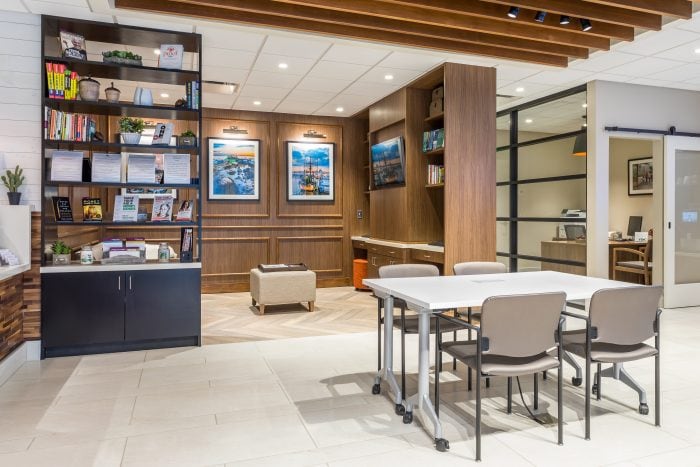
The mid-floor area converts for a variety of configurations. The rear library space provides workstations, comfortable seating & localized photography on the walls.
The solution created is unique in the Financial industry. Chelsea Groton focused solely on solving customer needs and as a result, transformed the company, the role of its associates, the design of the Financial Centers, the interactive tools used, its class curriculums, the tone of voice and terminology used and it’s overall impact on the community.
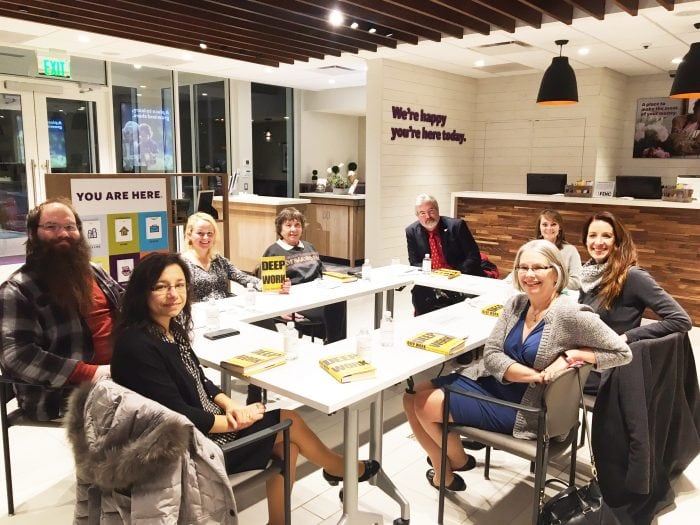
Dual function of the space for staff team meetings and customer educational workshops.
Local and national competitors alike are studying this project as an example of how a CX process can help transform businesses and positively impact lives.
At Little we’re passionate about Architecture, however our success is measured against the powerful impact strategic design offers for our clients’ businesses and their customers. Hear what our clients have to say below…
The branch has won two major awards including 1st Place in VM+SD Magazine’s Retail Renovation Competition presented at the International Retail Design Conference. The judges commented: “The end result wowed the judges. “Banks, and service retail, are challenging, through communicating information and merchandising, they gave theirs a home.” Read more in VMSD Sep 2018 Issue
Winner Best of Reader’s Choice Awards 2018 ‘Bank’ & Best of Reader’s Choice Awards 2018 ‘Financial Advisor’.
